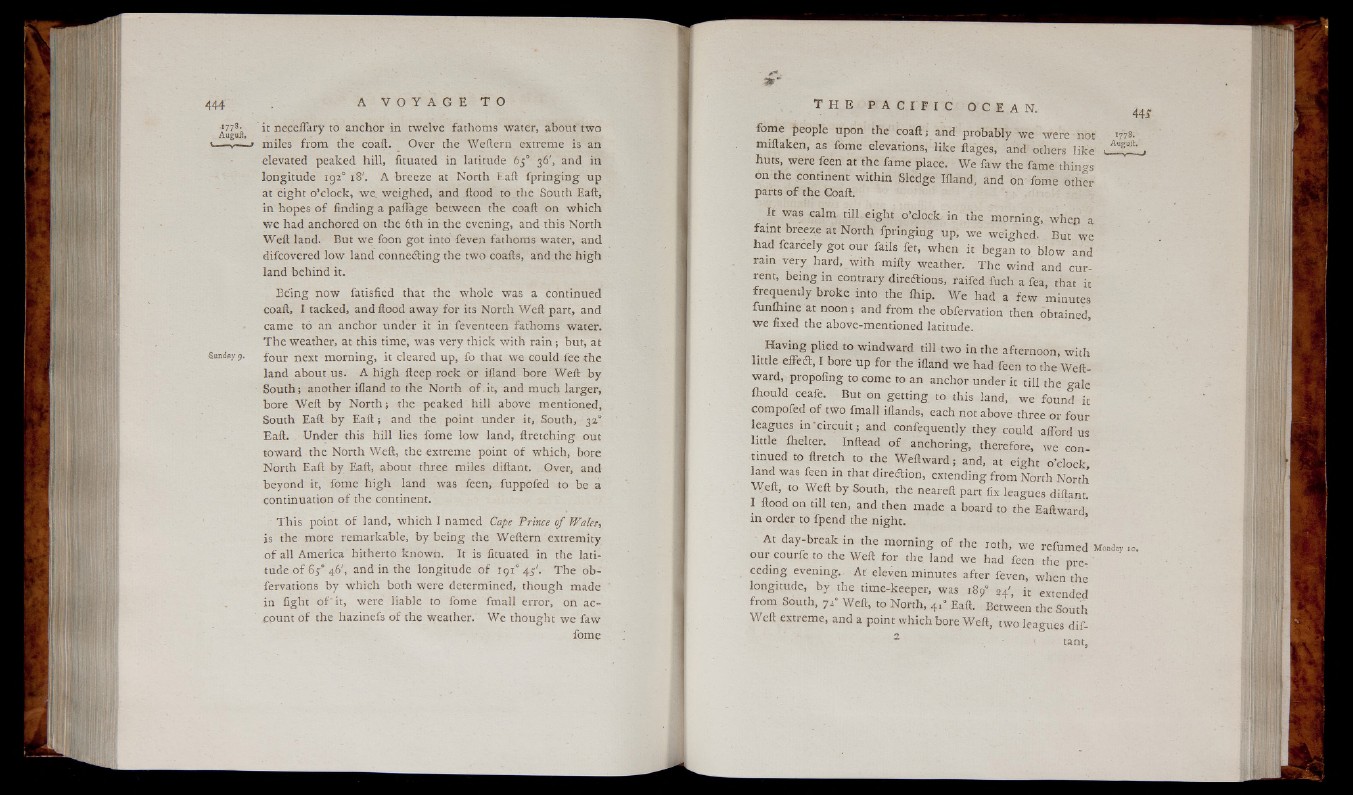
Hi
m m
.1 7 7 8 .
Auguft.
it neceflary to anchor in twelve fathoms water, about two
miles from the coaft. Over the Weftern extreme is an
elevated peaked hill, fituated in latitude 65° 36', and in
longitude 192° 18'. A breeze at North Eaft fpringing up
at eight o’ clock, we. weighed, and flood to the South Eaft,
in hopes o f finding a pafiage between the coaft on w hich
w e had anchored on the 6th in the evening, and this North
Weft land. But we foon got into feven fathoms water, and
difcovered low land connecting the two coafts, and the high
land behind it.
Being now fatisfied that the whole was a continued
coaft, I tacked, and flood away for its North Weft part, and
came to an anchor under it in feventeen fathoms water.
T h e weather, at this time, was very thick with r a in ; but, at
S u n d a y 9 . fou r next morning, it cleared up, fo that we could fee the
land about us. A h ig h fteep rock or iiland bore Weft by
South; another iiland to the North o f.it , and much larger,
bore Weft by North ; the peaked h ill above mentioned,
South Eaft b y E a ft ; and the point under it, South, 32"
Eaft. Under this h ill lies fome low land, ftretching out
toward the North Weft, the extreme point o f which, bore
North Eaft by Eaft, about three miles diftant. Over, and
beyond it, fome high land was feen, fuppofed to be a
continuation o f the continent.
T h is point o f land, which I named Cape Prince of Wales,
is the more remarkable, by being the Weftern extremity
o f all America hitherto known. It is fituated in the latitude
o f 67° 46', and in the longitude o f 191" 45'. The ob-
fervations by which both were determined, though made
in fight of" it, were liable to fome fmall error, on a c count
o f the hazinefs o f the weather. We thought we faw
fome
fome ¡people upon the coaft; and probably we were not
miftaken, as fome elevations, like ftages, and others lik e
hurs, were feen at the fame place. We faw the fame things
on the continent within Sledge Iiland, and on fome other
parts o f the Coaft.
It was calm till e ight o’clock in the morning, when a
farm breeze at North fpringing up, w e weighed. But we
had fcarcely got our fails fet, when it began to blow and
ram v e ry hard, with mifty weather. T he wind and current,
b eing in contrary diredions, raifed fuch a fea, that it
frequently broke into the ihip. We had a few minutes
funihine at n o o n ; and from the obfervation then obtained,
w e fixed the above-mentioned latitude.
Having plied to windward till two in the afternoon, with
little effect, I bore up for the iiland we had feen to the Weft-
ward, propofing to come to an anchor under it till the gale
fhould ceafe. But on g e ttin g to this land, we found it
compofed o f two fmall iflands, each not above three or four
leagues m ’ circu it; and confequently they could afford us
little fhelter. Inftead o f anchoring, therefore, we continued
to flretch to the W e ftw a rd ; and, at e ight o’clock,
land was feen in that direition, extending from North North
Weft, to Weft by South, the neareft part fix leagues diftant.
I flood on till ten, and then made a board to the Eaft ward
in order to fpend the n ight.
At d a y -b re a k in the morning o f the 10th, we refumed M o n d a y ,0 .
our courfe to the Weft fo r the land we had feen the preceding
evening.. At eleven minutes after feven, when the
longitude, b y the time-keeper, was 189° 34' i t extended
from South, 72” Weft, to North, 4 ,* Eaft. Between the South
Weft extreme, and a point which bore Weft, two leagues dif-
' tant,
1 7 7 8 .
Auguit.